#theodore von eltz
Text
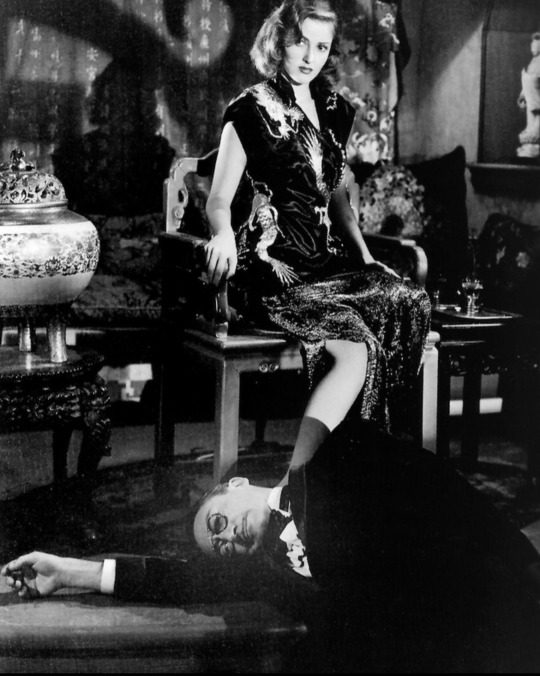
Martha Vickers and Theodore von Eltz in a cool publicity shot for The Big Sleep, 1946
96 notes
·
View notes
Text

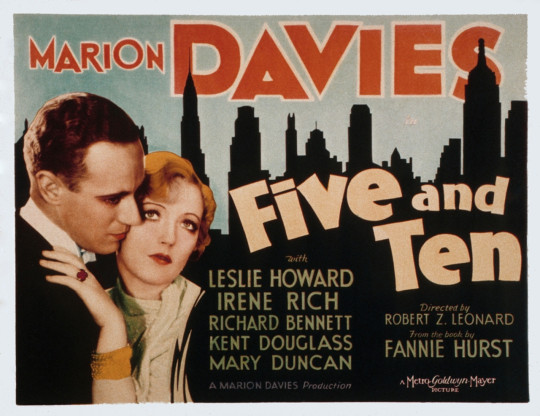
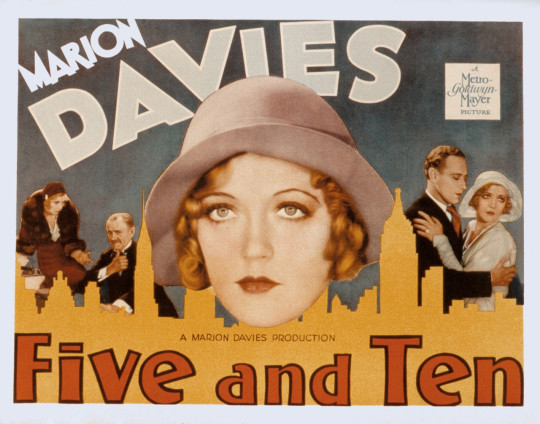







Five and Ten (Daughter of Luxury) (1931) Robert Z. Leonard
July 2nd 2023
#five and ten#daughter of luxury#1931#robert z. leonard#marion davies#leslie howard#richard bennett#irene rich#douglass montgomery#mary duncan#halliwell hobbes#theodore von eltz#pre code
9 notes
·
View notes
Text

Lionel Barrymore, Fredric March and Theodore von Eltz in a publicity still for The Road to Glory (1936)
1 note
·
View note
Text

John Gilbert, Eleanor Boardman, and Roy D'Arcy in Bardelys the Magnificent (King Vidor, 1926)
Cast: John Gilbert, Eleanor Boardman, Roy D'Arcy, Lionel Belmore, Emily Fitzroy, George K. Arthur, Arthur Lubin, Theodore von Eltz. Screenplay: Dorothy Farnum, Marian Ainslee (titles), based on a novel by Rafael Sabatini. Cinematography: William H. Daniels. Art direction: James Basevi, Richard Day, Cedric Gibbons.
This entertaining swashbuckler was long thought to be lost, apparently because of a contractual agreement between MGM and Rafael Sabatini, author of the novel on which it was based. When the studio failed to renew the rights to the novel in 1936, it destroyed the negative and all the prints it could get its hands on. Fortunately, 70 years later a print surfaced in France, missing only one reel that the restorers pieced together with production stills and footage from the original trailer. It was a good save, especially for the legacy of its director, King Vidor, and its star, John Gilbert. Vidor stages several lively swordfights and a memorable love scene in which Bardelys (Gilbert) woos Roxalanne de Lavedan (Eleanor Boardman) in a boat as it passes through the overhanging branches of a willow tree. But the film's highlight is a spectacular escape from the gallows, in which Gilbert (almost certainly with the help of his stunt double) outdoes Douglas Fairbanks in swinging from ropes and curtains, climbing walls, and fencing with pursuers. The story is romantic nonsense in which Bardelys, a womanizing marquis at the court of Louis XIII (Arthur Lubin) makes a wager that he can win the hand of Roxalanne, who has spurned the advances of the very hissable villain, Châtellerault (Roy D'Arcy). To win the bet, Bardelys finds himself assuming the identity of a man he finds dead, Lesperon (played by Theodore von Eltz in the missing reel), an enemy of the king. Sure enough, he and Roxalanne fall in love under the willows, but his imposture not only turns her against him when she finds proof that Lesperon is engaged to someone else, but also puts him in danger of being hanged for treason, especially after Châtellerault turns up and refuses to disclose that Lesperon is really Bardelys. Dorothy Farnum adapted the novel, and the cinematography is by William H. Daniels. The cast supposedly includes the 19-year-old John Wayne as a guard, in only his second film appearance, but good luck spotting him.
5 notes
·
View notes
Video
youtube
Marian Marsh | Gordon Oliver | Youth On Parole (1937) | Full Movie English
Youth on Parole is a 1937 US drama movie directed by Phil Rosen. The film stars Marian Marsh and Gordon Oliver "Bobbie" Blake and Phillip Henderson are strangers who happen to be looking in a jewelry store window when one of the jewelry store robbers sets them up to take the rap for the crime. He stashes some of the stolen jewels in their pockets as the Jewel thieves gang makes their getaway. No one believes that Bobbie and Phillip are innocent, not even their public defender. After they serve their time, no one will give them a break with their prison record. CAST Marian Marsh as 'Bobbie' Blake Gordon Oliver as Phillip Henderson Margaret Dumont as Mrs. Abernathy (landlady) Peggy Shannon as Peggy Miles Mander as Sparkler (gang leader) Sarah Padden as Mrs. Blair Wade Boteler as Mr. Blair Mary Kornman as Mae Blair Joe Caits as Fingy (robber) Milburn Stone as Ratty (robber) Harry Tyler as Danny Hinkle (cellmate) Ranny Weeks as Michael Martin Theodore von Eltz as The Public Defender Ula Love as Maizie Paul Stanton as Police inspector Never miss a video. Join the channel so that Mr. P can notify you when new videos are uploaded: https://www.youtube.com/@nrpsmovieclassics
0 notes
Photo










Stan Laurel, Martha Sleeper and Theodore von Eltz in Should Tall Men Marry? (1928)
#Stan Laurel#Martha Sleeper#Theodore von Eltz#Should Tall Men Marry?#1928#1920s#Stan's solo work#my gifs
9 notes
·
View notes
Photo






Bright Eyes-1934
#bright eyes#gif#1934#black and white film#Jane Withers#Theodore von Eltz#Dorothy Christy#David Butler#Shirley Temple#James Dunn#Charles Sellon
12 notes
·
View notes
Text
Stage star Lenore Ulric brings her signature role to the screen in this melodrama set in Canada. We have Mounties, trees and bloody revenge. The usual Hollywood Canadian wilderness picture, in other words, but we have the added bonus of a super Mountie and a location shoot in Yosemite.
Home Media Availability: Released on DVD.
This is my contribution to the O Canada Blogathon hosted by Silver Screenings and Speakeasy. Be sure to read all the other reviews!
Go get ‘em, tiger!
I do love Mountie flicks and I know I’m not alone. What’s not to love about noble gents in great hands tracking down evildoers? Unfortunately, the quality of Mountie pictures can be described as spotty at best. For every piece of quality entertainment, we have a few bombs. For example, Nomads of the North features Lon Chaney as a sexy fur trapper. Really. Where the North Holds Sway is essentially a western with more flannel. See what I mean? Well, let’s see if this picture will make up for the bad ones.
Will Forrest Stanley’s Mountie win us over?
Tiger Rose is an adaptation of a 1917 stage play written by Willard Mack (you can read a public domain copy here) and produced by the famed David Belasco, who had quite a number of western and wilderness pictures in his repertoire. Warner Bros. scored a casting coup when they obtained the services of Lenore Ulric, who had created the role of Rose on the stage and had not been seen in movies in six years. The film was subsequently remade as both a silent and a talkie as a 1929 Lupe Velez vehicle but, alas, the remake is not on home video.
(I should note that the version of the film I saw runs for just one hour. Tiger Rose as originally released ran for eight reels, which would be eighty minutes at minimum and likely far longer. The storyline is smooth and I did not notice any particularly large holes in the plot.)
The things you find when you go fishing.
The film opens in a quiet Canadian trading community that bears a shocking resemblance to Yosemite. (Mainly because the exteriors were shot there. Whodathunkit?) Sergeant Michael Devlin (four-time Marion Davies leading man Forrest Stanley) is a Mountie’s Mountie and he comes riding hell for leather into town. He has fished a half-drowned woman (Lenore Ulric) out of Loon River and turns her over to the kind locals for some first aid.
We know that this young woman has been through a lot because she looks like this:
I wish I could look that good after almost drowning.
Yipes! When they say “waterproof” on the mascara bottle, they mean it! And who made her hairspray? Color me impressed.
Devlin tells the story of his brave rescue in flashback and it strikes me that this would have been a far more impressive opening scene for the film than shots of the great outdoors. Devlin races on horseback to catch up with the woman in the water—she’s caught in a current heading for a waterfall because this is a melodrama—and then he dismounts and throws himself off a cliff into the river below. That is some grade A stunt work and it’s a pity that the suspense is spoiled by using the flashback structure.
Now THAT is what I call an epic rescue.
Anyway, the young woman is named Rose and she likes to hunt and swear in the most adorable way possible. Devlin is interested but Rose falls for Bruce Norton (Theodore von Eltz), a dashing engineer. (Not there are two words I never thought I would type in the same sentence.) It’s love at first sight but Bruce is on a mission: he has tracked down a nefarious bad guy-type and he means to kill him for the sake of someone called “Helen.” There’s a suitably violent struggle for a pistol and Bruce ends up shooting his target, one of the local doctors.
When confronting one’s arch-nemesis, one would think one would be on the lookout for hidden weapons.
Another local doctor (this town is flush with ‘em, it seems) examines the body and delivers a mysterious proclamation. It seems that everyone in this picture has decided to become Lemony Snicket. The second doctor is played by Sam De Grasse, noted villain of Fairbanks flicks, and he sets out to help Bruce… or does he?
Devlin receives news of the murder and springs into action. He takes his trusty rifle and is able to wing Bruce lickety-split. Bruce is in a pickle as a storm is coming in and Devlin’s posse has the area surrounded. He takes refuge in Rose’s cellar, where she and the doc discover him a bit later. But Devlin hasn’t given up the chase and it’s going to take a very clever plan to evade our unstoppable Mountie.
Bruce learns that Devlin plays for keeps.
Will Bruce get away? Do we really want him to get away? I mean, that Devlin guy is pretty cool. In any case, find out in Tiger Rose!
Lenore Ulric does well overall but her Broadway experience causes her to play things in a broad way. (Get it? Get it?) It’s not too distracting but there are a few scenes in which her gestures get out of control and I wish I could assure her that we saw her in the nickel seats. She also applies her makeup with a trowel, which is distracting alongside the more subtle cosmetics of her costars and the general grit and outdoorsiness of the picture. (Makeup in the silent era was wildly inconsistent but the basic rule was that the actors should try to match one another in general amount and application.)
I’ve got a fever and the only prescription is more lipstick.
Ulric is further hampered by silly title cards that attempt to mimic French Canadian dialect. And does her background ever amount to anything in the picture? It does not. I am on record as hating dialect title cards and unnecessary dialect title cards are even worse. Frankly, it’s amazing that Ulric manages to rise above the silliness.
This slideshow requires JavaScript.
Let’s face it, Rose’s motivation is a little weak. She met Bruce the day before and had a flirtation that lasted all of five minutes, that hardly seems like a good reason to risk everything for him. But… this is a melodrama. Love at first sight is a staple. What’s more problematic is the fact that her contributions to the story are pretty much superfluous. The doc and Bruce would have escaped on their own and the ending of the film (being intentionally vague here) would have been essentially the same with or without Rose. Yes, it’s fun to see a silent heroine wield a pistol but it’s not unheard-of. (See Back to God’s Country, a smashing Canadian wilderness picture in which Nell Shipman saves the day with firearms and a killer dog.)
For Helen –
You will always be in my heart,
In my mind,
And in your grave.
Theodore von Eltz is okay as Bruce but the film misfires when it plays Button Button with his past and motivation. It would have been far more believable if he had confided his sad tale to Rose. As the film stands, the leads are forced to run around being terribly mysterious when any normal person would be asking some questions. “Um, why’d you shoot the guy? I know the doc said you had good reasons but I’d kinda like some clarification. Also, do you shoot girls? Asking for a friend.” Look, this mournful “Oh, my horrible past that I will not clarify!” stuff is amusing in A Series of Unfortunate Events but it gets rather tedious in a drama.
This looks like a job for… Devlin the Super Mountie!
I usually find Forrest Stanley to be a bit on the dull side but I really liked Devlin the Super Mountie. He doesn’t show up much in the beginning but every time he does, he performs some splendid stunt, strikes a heroic pose and otherwise shows himself to be Trustworthy, Loyal, Helpful, Friendly, Courteous, Kind, Obedient, Cheerful, Thrifty, Brave, Clean, and Reverent. In our world of gravel-voiced antiheroes, Devlin’s unabashed good guy-ness is a positive breath of fresh air and Stanley manages to do it all without coming off as sanctimonious or trite.
No villain is safe on Canadian soil!
Devlin’s whole “unstoppable manhunting force for good” act just gets better and better as the film progresses. I don’t know about everyone else but I was definitely rooting for him to get his man. The fact that Bruce’s motivation is not revealed until the finale makes him a rather opaque hero, which in turn makes Devlin’s straightforward lawman stuff even more appealing. Why were there no Sgt. Devlin of the RCMP spinoffs? Come on, people, you missed a huge opportunity!
Looks trustworthy to me.
I have to say, though, that the casting of Sam De Grasse really threw me off. Here’s a man who can make picnics and candy and flowers look sinister and he spends the entire picture lurking about in a most ominous manner. I kept expecting him to stab Bruce in the back or something.
Legendary cinematographer Charles Rosher makes the most of the films Yosemite locations and the cast is frequently posed against lovely natural backdrops. Hey, if you’ve got it, you flaunt it. He does equally well with the moody shadows of the nighttime storm scenes. The man was good, is what I’m saying. Check it out:
When interviewed by Kevin Brownlow for The Parade’s Gone By, Rosher revealed the film was significant in his career as it was the only time movie mogul Harry Warner ever gave him (or anyone else) a bonus. Lenore Ulric was due back in New York for rehearsals and if the film was not finished in time, the entire crew would have to follow her to the east coast and finish making it there at great expense.
She has a schedule to keep and you do not want to cross her.
Director Sidney Franklin was too nice to rush things along so Rosher took over the role as expediter and the picture was finished on schedule. Ulric got to New York in time, Warner Bros. didn’t have to move production across the country and everyone was happy. Harry Warner personally thanked Rosher and told him that shooting in the east would have added $25,000 to the film’s budget. There was a funny bit of business where Warner wouldn’t let go of the check but Rosher got his bonus in the end. Fully deserved too, I might add.
(Rosher also received a telegram from Belasco himself complimenting him on his camera work. Rosher claimed it was just because Ulric, a Belasco favorite, liked her closeups.)
In the cellar, out of the cellar, in the cellar… make up your minds!
But back to the film as we need to discuss some significant flaws. The main issues of the story come from the script. Its stage roots show particularly in the third act as the story’s setbound nature becomes obvious. The leads scamper from the house to the cellar to the house to the cellar to the cabin to the house. Rosher and Franklin try their best to open things up with shots of the great outdoors but there’s only so much that can be done and the story ends up feeling a bit claustrophobic.
No, sitting under a staircase doesn’t count as a scene change.
(Spoilers Ahoy!)
The finale of the film descends into absolute Victoriana, coincidences and all. It turns out that the doc was Bruce’s brother-in-law all along and it looks like everyone is going to get away when Devlin reveals himself and begins to make his arrest. Rose springs into action and holds Devlin back with a pistol while Bruce and the doctor escape. This means prison for Rose but after holding Devlin prisoner all night, Bruce returns to turn himself in and save her from sacrificing herself. Why they didn’t just tie Devlin up and all escape together, I have no idea. In any case, Devlin is moved by the gesture but he still arrests Bruce.
Hurray! You know, for people whose Hollywood motto is, “We always get our man,” the Mounties certainly seem to let a lot of fugitives go. I’d complain but then I remember that I almost never get my mail delivered during snow, sleet and dark of night. Hollywood needs more realistic mottos for its government organization. “We always get our man unless he’s dating that girl we used to like.” Well, not this time! Devlin remains a Mountie’s Mountie and thank goodness. Of course, Bruce just gets a few months in the pokey, which kind of retroactively nullifies the urgency of his escape. “I need to get away! I can’t serve six months! It’s inhuman!”
(End Spoilers)
Goodby and good luck in your new life, Rose. I planted cocaine in your dog sled.
Is it worth seeing? Oh, definitely. Tiger Rose is as corny as can be and no Mountie film cliché is left out, though some are twisted about and played with. Also in the plus column, the cast is game, Rosher’s cinematography is gorgeous and it’s all in good fun. If you get into the spirit of the thing, I think you’ll have a great time. It’s one of the better Mountie flicks of the silent era.
P.S. #TeamDevlin
Where can I see it?
Tiger Rose is available on DVD from Grapevine.
Tiger Rose (1923) A Silent Film Review Stage star Lenore Ulric brings her signature role to the screen in this melodrama set in Canada.
#1923#Action Adventure#Charles Rosher#Forrest Stanley#Lenore Ulric#Sidney Franklin#Theodore von Eltz#Tiger Rose
2 notes
·
View notes
Text
California Straight Ahead! ** (1937, John Wayne, Louise Latimer, Robert McWade) - Classic Movie Review 9880
California Straight Ahead! ** (1937, John Wayne, Louise Latimer, Robert McWade) – Classic Movie Review 9880
Director Arthur Lubin’s 1937 black and white adventure California Straight Ahead! stars John Wayne, who leads this Universal Pictures second feature about rivalry in the US transcontinental shipping business.
The rivalry leads to a cross-country race between James Gifford (Theodore von Eltz)’s train and an ultra-fast lorry driven by Biff Smith (Wayne), co-owner with Charlie Porter (Emerson…
View On WordPress
0 notes
Link
For just $3.99 Released on March 11, 1935: Crime adventure based on the autobiography of New York Police captain Cornelius W. "The Gang Buster" Willemse. Genre: Crime Duration: 1h 8min Director: Christy Cabanne Actors: Norman Foster (Detective Lieutenant Dave Britten), Judith Allen (Mary Kennedy), Sidney Blackmer (Raymond Cortell), Purnell Pratt (Detective Lieutenant Jim Kennedy), Theodore von Eltz (John C. Owen), Ford Sterling (Max Shultz, janitor), Kenneth Thomson (Charles T. 'Ritzy' Conrad), Lloyd Whitlock (assistant District Attorney), Edward Hearn (Detective Brewster), Jane Meredith (Mrs. Gorham), Edward Hearn (detective Brewster), Jane Meredith (Mrs. Gorham), Edward Gargan (Moran, policeman), J. Carrol Naish (Sam Dover), John Davidson (Beasley), Hooper Atchley (District Attorney Marsden), Marc Loebell (Manny Spivalo), Fern Emmett (Sarah, cook), John Ince (first judge), Ralph Lewis (second judge, and a lawyer), Harry Bowen ('crooner' cop), Lynton Brent (court clerk), Allan Cavan (Crotell's receptionist), Jack Cheatham (police operator), Steve Clark (court clerk), Harry Harvey (reporter), Warren Jackson (medical examiner), Fred Parker (juror), Dick Rush (desk sergeant), Harry Strang (reporter), Herb Vigran (photographer). *** This item will be supplied on a quality disc and will be sent in a sleeve that is designed for posting CD's DVDs *** This item will be sent by 1st class post for quick delivery. Should you not receive your item within 12 working days of making payment, please contact me so we can solve this or any other questions. Note: All my products are either my own work, licensed to me directly or supplied to me under a GPL/GNU License. No Trademarks, copyrights or rules have been violated by this item. This product complies with rules on compilations, international media, and downloadable media. All items are supplied on CD or DVD.
0 notes
Text
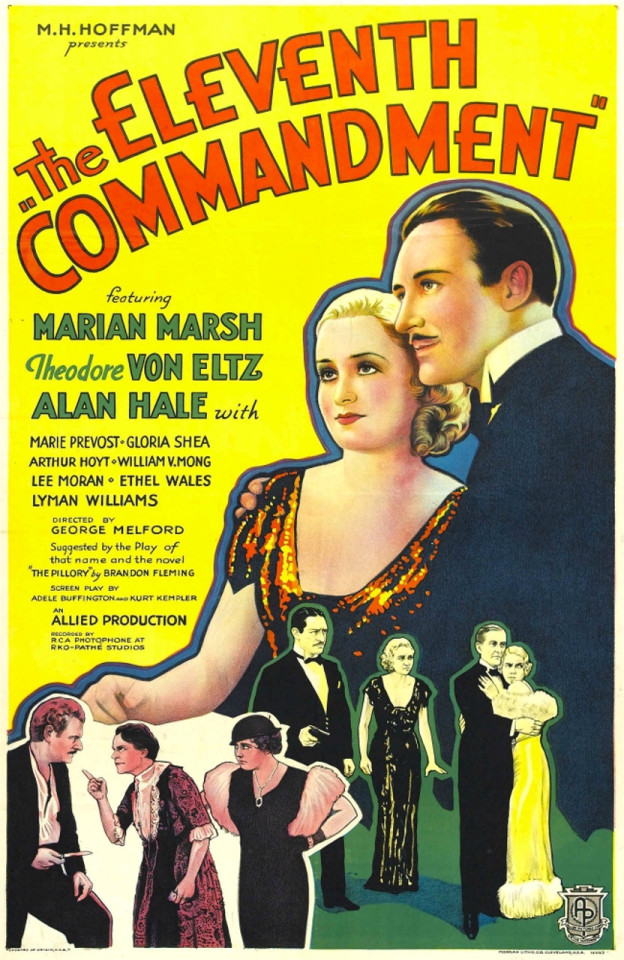
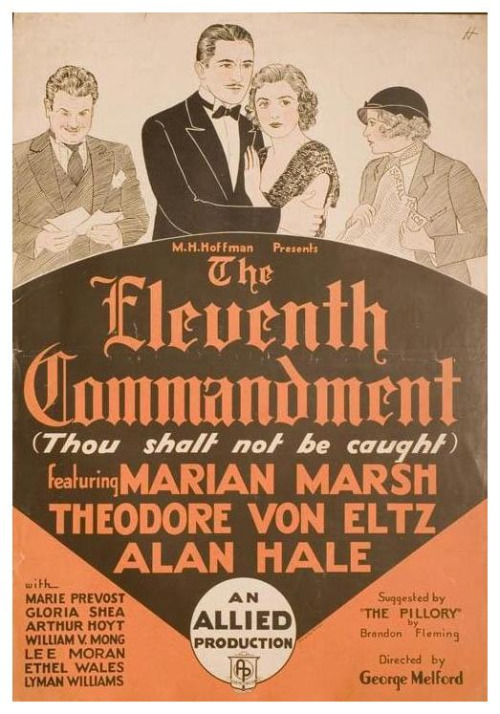
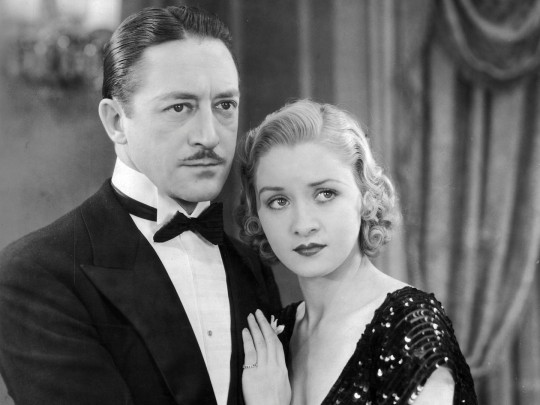
The Eleventh Commandment (1933) George Melford
December 2nd 2023
#the eleventh commandment#1933#george melford#marian marsh#theodore von eltz#marie prevost#alan hale#ethel wales#arthur hoyt#gloria shea#william v. mong#lee moran#pre-code
0 notes
Text

Brian Donlevy and Glenda Farrell in High Tension (Allan Dwan, 1936)
Cast: Brian Donlevy, Glenda Farrell, Norman Foster, Helen Wood, Robert McWade, Theodore von Eltz, Romaine Callender, Hattie McDaniel, Joe Sawyer, Murray Alper. Screenplay: Lou Breslau, Edward Eliscu, John Patrick, J. Robert Bren, Norman Houston. Cinematography: Barney McGill. Art direction: Duncan Cramer. Film editing: Louis R. Loeffler.
High Tension is a lively little action comedy that comes in at 63 minutes, just right for the bottom half of a double feature. Brian Donlevy has the boisterous role of Steve Reardon, an underwater engineer for a transoceanic cable company who unwinds from his stressful job by getting drunk, telling tall tales of his undersea adventures, getting into fights, and messing around with his girlfriend, Edith McNeil (Glenda Farrell). It's a little hard to see why she puts up with Steve, let alone wants to marry him, except that she makes a good living writing pulp fiction based on those tall tales. Allan Dwan sets a nice pace for the movie, which puts Steve into a couple of knock-down, drag-out fights, one of which involves Steve and his opponent shoving a piano at each other in Edith's apartment. The more important fight, for the sake of the plot, comes when a couple of guys (one of them played by an unbilled Ward Bond) set upon him with the aim of picking his pocket. The movie's second lead, Eddie Mitchell (Norman Foster), manages to save the money that the thugs stole from Steve when he was knocked cold. Steve wakes up the next morning to find himself in bed with Eddie, who took him home for the night. It's the beginning of a beautiful friendship, with whatever homoerotic undertones you might want to find in it. Grateful for Eddie's help, and discovering that he has a degree from Caltech, Steve gets him a job with the company he works for and trains him to be his right hand man. Eventually, all this winds up with some romantic complications, with Steve, who has broken up with Edith, putting the moves on Eddie's pretty secretary (Helen Wood), whom the shy Eddie secretly loves. And there's a big underwater rescue scene (done pretty much on the cheap) that sets everything straight again. The whole thing is quite watchable, except for the sexist and racist elements that don't go down as well today as they did in the '30s. Steve has to deal with his boss's prissy assistant, F. Willoughby Tuttle (Romaine Callender in a role probably written with Franklin Pangborn in mind), a prime example of the "pansy" stereotype that afflicted movies of the era. And Hattie McDaniel is cast as Edith's maid, unimaginatively named Hattie, a role that McDaniel plays with more sass and vigor than it deserves -- McDaniel was a true professional, and if you can overlook the stereotyping her performance is a delight.
1 note
·
View note
Text
Today in Soap Opera History (August 31)
On this date in...
1948: Radio soap opera The Guiding Light, still almost four years away from making its way to television, introduced the character of Friedrich "Papa" Bauer. Theodore von Eltz originated the role and was replaced by Theo Goetz a year later. Goetz would remain with the show until his death in 1972.
1984: On Guiding Light, returning from a trip to Tulsa, H.B. Lewis (Larry Gates) was thrilled to see his paralyzed son, Joshua (Robert Newman), was now able to stand up.
1984: On Santa Barbara, Santana Andrade (Ava Lazar) was bit by a rattlesnake. She was rescued by C.C. Capwell (Peter Mark Richman).
2010: On As the World Turns, the Hughes family said goodbye to Nancy (Helen Wagner).
CREDIT: x
0 notes
Photo

New Post has been published on http://www.classicfilmfreak.com/2017/08/10/big-sleep-1946-starring-humphrey-bogart-lauren-bacall/
The Big Sleep (1946) starring Humphrey Bogart and Lauren Bacall


“Let me do the talking, angel. I don’t know yet what I’m going to tell them. It’ll be pretty close to the truth.”-Philip Marlowe
Seven bodies! At least that’s the rumored total in Raymond Chandler’s novel The Big Sleep. When William Faulkner and Leigh Brackett were working on the film’s screenplay and couldn’t discern who had murdered one character, they called the author. Chandler told them his identity was in the book, to read it. After checking his own novel, Chandler called back sometime later and told the writers that he didn’t know, that they could designate the killer as they liked.
The two screenwriters, even with the talents of a third, Jules Furthman, remained confused by the already confusing first novel of Chandler, and generally retained that murkiness, which might be one of the film’s charms. The Big Sleep is the best of the few detective films Warner Bros. made after The Maltese Falcon during the 1940s. If not plot, then, the big pluses include the tight direction of Howard Hawks, the sharp-edged dialogue—there’s a lot of talking—and the romantic repartee between its two stars, Humphrey Bogart and Lauren Bacall.
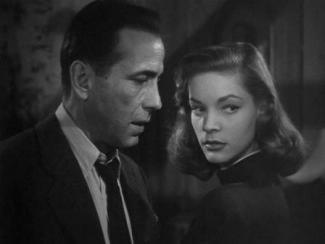
Despite Bacall’s come-hither, deep-voiced overtures to her leading man, anyone who has seen the first scene will be astounded by the schoolgirl teasings, no less provocative, of Martha Vickers as a precocious nymph, Bacall’s sister in the film, and wonder why she’s not seen more.
In fact, Vickers’ sexy chemistry was so threatening to the studio’s new discovery—this only Bacall’s fourth film after her sensational début in To Have and Have Not (1944)—that most of the younger (by about eight months) star’s scenes were cut. A major overhaul of Bacall’s part by the studio and director ensued, with reshoots, new scenes and added sexual innuendos between her and Bogart.
Filming was further complicated by the tension of Bogart’s impending divorce from his third wife and the affair he was conducting on the set with Bacall. Rumor had it that Bacall was so nervous over the divorce, and, from some sources, that the actor was still debating whether to proceed with the divorce, that during filming her hands shook when she poured a drink or lighted a cigarette.

Bacall had written in her autobiography, By Myself, that, despite the anxiety over the divorce, much fun was had on the set, which prompted a cautionary memo from studio head Jack L. Warner. And when the most famous of the screenwriters, William Faulkner, author of The Sound and the Fury and other stories of the South, asked Hawks if he could write “from home,” since the studio atmosphere unnerved him, Hawks okayed the request, assuming the writer meant his office at the studio. The director was quite displeased when he learned that Faulkner was writing from“home” all right—in Oxford, Mississippi.
Some brave souls have tried to condense the impenetrable plot into a nutshell, though, at best, it’s of minimum importance. Let’s see, how does it go, or appears to go. . . .
Private detective Philip Marlowe (Bogart) visits a decaying old man, General Sternwood (Charles Waldron, who died before the film was released), who sits, wheelchair-bound, shawl-enshrouded, in his putrefying greenhouse. (In the 1978 remake, James Stewart’s portrayal of the role seems more a copy of Waldron’s performance than any original approach of his own.) The dialogue in this one scene, and coming so early in the film, can be seen as setting the ethical tone of the movie and the nature of the characters, the private eye included.
The General says to Marlowe:
“You may smoke, too. I can still enjoy the smell of it. Hum, nice state of affairs when a man has to indulge his vices by proxy. You’re looking, sir, at a very dull survival of a very gaudy life—crippled, paralyzed in both legs, barely I eat and my sleep is so near waking it’s hardly worth the name. I seem to exist largely on heat, like a newborn spider.”
He tells Marlowe that he’s being blackmailed, again, and asks him to check on the gambling debts his younger daughter, Carmen (Vickers), owes to a book dealer named Geiger (Theodore von Eltz). (Carmen is a nymphomaniac in Chandler’s novel, but the Hollywood censors would permit no more than what is seen; any inferences otherwise must be the viewer’s own.)

As Marlowe is leaving, the butler (Charles D. Brown) tells him Mrs. Vivian Rutledge (Bacall) would like to see him. In trying to feel him out, she confides that she believes her father has asked him to search for his friend Sean Regan, who has been missing for a month.
Next scene, Marlowe visits Geiger’s rare bookstore (a source for pornography in Chandler’s novel). With the front of his hat turned up, he assumes a clipped speech and eccentric manner, asking for specific editions of two books. The proprietor (Sonia Darrin) says she doesn’t have them.
He then goes across the street to another book store run by a proprietress (Dorothy Malone) who comes on to Marlowe, and he to her. He asks her for the same editions of the books and she rightly tells him there are none. “The girl in Geiger’s bookstore,” he says, “didn’t know that.”
He asks her if she knows Geiger on sight, she describes him down to his glass eye and he requests she let him know when he comes out of the bookstore. (The three-and-a-half-minute scene is one of the best in the film, and, interesting, like Marlowe’s scene with Sternwood, it exudes rapport and chemistry without Bacall.)

When Geiger does emerge, Marlowe follows him to a house. Hearing a woman’s scream and a gunshot, he enters to find a dead Geiger, a drugged Carmen and a hidden camera, without any film. After taking Carmen home, he returns to the house, only to find . . . the body is gone.
It’s just the beginning, and from here on it’s nothing but a convoluted, indecipherable mess, first and most prominent, murder, then gambling, blackmail, car chases (not the apoplectic ones of today), love triangles, red herrings, organized crime, subtle suggestions of pornography and general mayhem.
Although no threat to the overwhelming charisma between Bogart and Bacall, the dialogue has its own fascination, often poetic and occasionally unforgettable, however “written” it may sometimes sound. This is true of General Sternwood’s lines in his one scene and in some of Marlowe’s, particularly this retort during his first scene with Vivian, when she says she deplores his manners:
“And I’m not crazy about yours. I didn’t ask to see you. I don’t mind if you don’t like my manners. I don’t like them myself. They are pretty bad. I grieve over them on long, winter evenings. I don’t mind you ritzing me or drinking your lunch out of a bottle, but don’t waste your time trying to cross-examine me.”

These lines, some given at a fast, breathless pace, are reminiscent of a Bogart scene in The Maltese Falcon—the address to the district attorney about “the only chance I’ve got of catching them [the murderers], and tying them up, and bringing them in, is by staying as far away as possible from you and the police . . . ”
The most famous dialogue exchange, with its sexual innuendos, is between Bogart and Bacall, sitting across from each other at a nightclub table:
“Speaking of horses,” she says, “I like to play them myself. But I like to see them work out a little first, see if they’re front runners or come from behind, find out what their hole card is, what makes them run. . . . I’d say you don’t like to be rated. You like to get out in front, open up a little lead, take a little breather in the backstretch and then come home free.”
“You don’t like to be rated yourself,” he says.
“I haven’t met any one yet who can do it. Any suggestions?”
“Well, I can’t tell till I’ve seen you over a distance of ground. You’ve got a touch of class, but I don’t know how far you can go.”
“A lot depends on who’s in the saddle.”
This scene doesn’t need, and doesn’t receive, any underpinning music. Max Steiner’s musical score is one of his more problematic, containing both the strong and weak points of his style. The main title is something of a nondescript blur, noisy and tuneless, serving, if nothing else, as a foretaste of the impervious plot and unsavory characters.

In the insouciant motif for Philip Marlowe, Steiner captures the detective’s sluggish, yet quixotic nature, which serves to brighten the predominantly dark music. The slowly ascending notes at the start of the main love theme suggest, perhaps—assuming Steiner’s thinking was this nuanced—the hostile beginning of Marlowe and Vivian’s relationship, the rest of the theme infused with a kind of smothered passion their love would become by the end.
In scoring for two similar settings, it is interesting to compare the disparate approaches to the greenhouse scene, with all its tropical trees and ferns, and Violet Venable’s (Katharine Hepburn) jungle garden in Suddenly, Last Summer (1959). For whatever the reason, Steiner elects to ignore representing the humid atmosphere General Sternwood has prepared for his orchids, while composers Malcolm Arnold and Buxton Orr convey almost breathable damp and mildew for Violet’s steamy surroundings.
The Big Sleep is a film where everyone except General Sternwood—perhaps he, too, if he had another scene—carries a gun, and when guns are unavailable, then fists do quite well. With the moral slant of the film, that is, with less than admirable characters and their ugly motives, it’s hard to like any of them.

Truth is, you’re not supposed to like the characters in a film noir, sympathize with them maybe.. But the actors you can like. It’s hard not to like Bogart and Bacall—not as accomplished actors, but as personalities of the screen, as stars were viewed in the ’30s and ’40. Then movie-goers didn’t go to see Philip Marlowe or Vivian Rutledge, not that any one coming out of the theater would remember her last name; they went to see Bogart and Bacall.
Bogart, like Cagney and Flynn, is a personality, a man who always, or generally always, plays himself. Bacall, who still hadn’t learned to act at the time of The Big Sleep, would have been easily overshadowed by Vickers had her original scenes been left intact, and Dorothy Malone has all the charisma and magic of Bacall, just another kind of charm.
Bosley Crowther, one of the most famous movie critics of the 1940s, warned in his New York Times review of August 24, 1946, that the film would be confusing and unsatisfying. And apparently in all sincerity, he asked, “[W]ould somebody also tell us the meaning of that title . . . ” Why, it’s what seems obvious, that which at least seven of the characters in The Big Sleep experienced . . . DEATH.
https://www.youtube.com/watch?v=n-K49CUaeto
0 notes
Photo










Should Tall Men Marry? (1928)
#Stan Laurel#Martha Sleeper#Theodore von Eltz#James Finlayson#Should Tall Men Marry?#1928#1920s#Stan's solo work#my gifs
25 notes
·
View notes